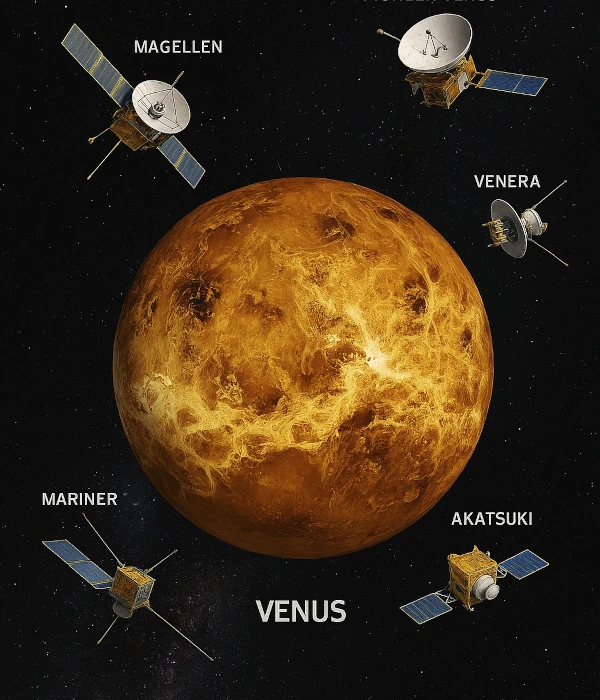
Venus, the second planet in the solar system, fascinates with its extreme conditions and initial resemblance to Earth. Since the 1960s, numerous space probes have been sent to study its dense atmosphere, chemical composition, and geology. These missions have allowed the observation of phenomena such as the extreme greenhouse effect, sulfuric acid clouds, and active volcanoes. The probes were launched by various space agencies, notably the Soviet Sergei Korolev (1907-1966) and NASA.
The first missions to Venus were the Soviet Venera and American Mariner programs. The Venera probes were the first to penetrate the atmosphere and transmit images from the surface. More recent missions, such as the Japanese JAXA's Akatsuki, have studied the climate and upper clouds.
Venusian probes carry various instruments: spectrometers, cloud-penetrating radars, magnetometers, and cameras. These instruments measure pressure, temperature, chemical composition, and topographical features. Radar use has been essential for mapping a surface completely invisible in the visible spectrum.
| Mission | Developed by | Launch year | Type | Scientific objective |
|---|---|---|---|---|
| Venera 4 | USSR | 1967 | Lander / Atmospheric probe | Direct measurement of pressure, temperature, and atmospheric composition |
| Venera 5 | USSR | 1969 | Atmospheric probe | Atmospheric and temperature measurements |
| Venera 6 | USSR | 1969 | Atmospheric probe | Atmospheric and density measurements |
| Venera 7 | USSR | 1970 | Lander | First successful landing and transmission of surface data |
| Venera 8 | USSR | 1972 | Lander | Atmospheric analysis and surface measurements |
| Venera 9 | USSR | 1975 | Lander / Orbiter | First images of the surface and geological analyses |
| Venera 10 | USSR | 1975 | Lander / Orbiter | Images and atmospheric measurements |
| Venera 13 | USSR | 1981 | Lander | Color images of the surface and chemical analyses of rocks |
| VEGA 1 | USSR | 1984 | Orbiter / Balloon / Lander | Release of balloons in the atmosphere, study of clouds and cometary flyby |
| VEGA 2 | USSR | 1985 | Orbiter / Balloon / Lander | Release of balloons in the atmosphere, study of clouds and cometary flyby |
| Mariner 2 | NASA | 1962 | Flyby | First scientific measurements of temperature and solar radiation |
| Mariner 5 | NASA | 1967 | Flyby | Study of the atmosphere, magnetosphere, and ionosphere |
| Mariner 10 | NASA | 1973 | Flyby / Gravitational assist | Unique flyby to accelerate trajectory to Mercury, limited atmospheric measurements |
| Pioneer Venus 1 (Orbiter) | NASA | 1978 | Orbiter | Detailed study of the atmosphere and radar mapping of the surface |
| Pioneer Venus 2 (Multiprobe) | NASA | 1978 | Landers / Atmospheric probes | Measurements of temperature, pressure, atmospheric composition, and winds |
| Magellan | NASA | 1989 | Orbiter | Complete radar mapping of the surface |
| Venus Express | ESA | 2005 | Orbiter | Study of climate, clouds, ionosphere, and atmospheric structure |
| Akatsuki | JAXA | 2010 | Orbiter | Observation of upper clouds, winds, and meteorological activity |
| Galileo | NASA | 1989 | Flyby / Gravitational assist | Flyby for acceleration to Jupiter, limited atmospheric measurements |
| Cassini | NASA / ESA / ASI | 1998 | Flyby / Gravitational assist | Flyby for acceleration to Saturn, limited atmospheric measurements |
| MESSENGER | NASA | 2004 | Flyby / Gravitational assist | Flyby for acceleration to Mercury, limited measurements |
Source: ESA – Venus Express.
In recent years, spectroscopic studies have suggested the possible presence of organic molecules in Venus's atmosphere, particularly in the cloud layer at about 50-60 km altitude. In 2020, an international team announced the detection of PH3, a molecule containing phosphorus and hydrogen, via observations made with the James Clerk Maxwell Telescope and the Atacama Large Millimeter/submillimeter Array (ALMA). Phosphine is known on Earth as a potential indicator of biological activities in anaerobic environments.
This discovery sparked great interest, as it could indicate unusual chemical processes or, more speculatively, the presence of microbial life forms in Venus's clouds. However, subsequent analyses have shown that the signals attributed to phosphine could be explained by non-biological chemical phenomena, such as photochemical reactions in the acidic atmosphere.
Future missions to Venus, such as ESA's EnVision or the American DAVINCI+ mission, should help clarify this issue by directly measuring the chemical composition of the clouds and precisely searching for organic molecules.
Source: Greaves et al., 2020, Nature Astronomy – Phosphine on Venus.